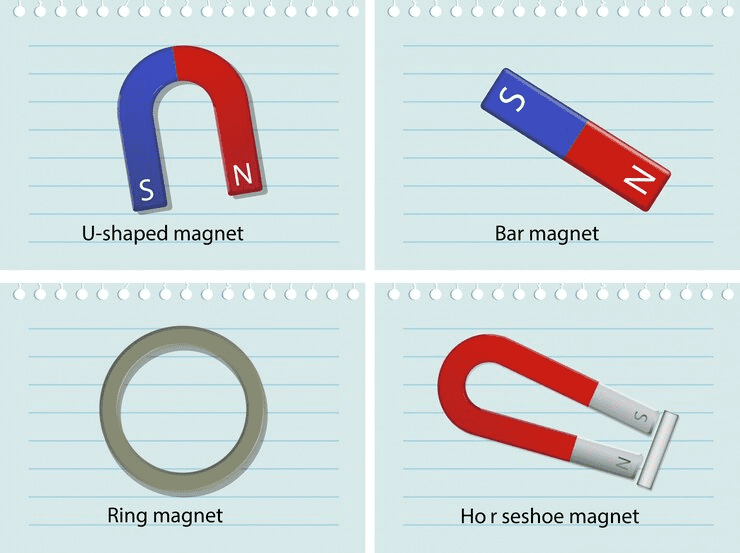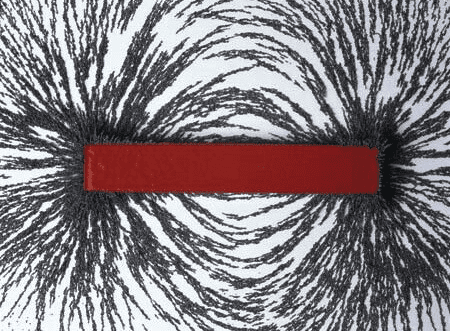Before starting with Class 6 Science Chapter 10 i.e. ‘Fun with Magnets’, I am hoping that you have completed the 9th chapter. If not, then you can go through its Notes and NCERT Exercise Solutions whose links have been provided below. ⤵️
Table of Content
Introduction
Have you ever noticed that the door of a refrigerator closes on its own after a gentle push?
Or, have you ever seen those stickers that remain attached to iron surfaces like on the doors of Almirah, refrigerators, etc?

Or, have you noticed those flip covers for smartphones or those handbags whose lids close without a locking arrangement?
Or, have you noticed a crane picking up a large load of iron scraps from a junkyard with the help of a block attached to the long hand?

All these objects have magnets in them. And, if you have any of these items then you can try to locate the magnet.
How Were Magnets Discovered?
The story of the discovery of magnets dates back thousands of years in Greece. There once lived a shepherd named Magnes.

He used to take his herd of sheep to nearby mountains for grazing. And, he always used to carry a stick with him to control his herd and his stick had a small piece of iron attached at one end. One day, while he was out in the mountains with his sheep, he noticed that his stick was getting stuck to a weird rock and he had to pull hard to free his stick from that rock.
Well, that rock was a natural magnet and it was attracting the iron tip of the shepherd’s stick.
And, children this is how natural magnets were discovered.
Such rocks that were attracting irons were given a name i.e. Magnetite (named after Magnes). Magnetite contains iron.
Some people believe that magnetite was first discovered at a place called Magnesia in Greece.
Then, later different kinds of rocks were discovered that had the property of attracting iron and they all are known as the natural magnets.
Later on, the process of making magnets from pieces of iron was discovered and these magnets are known as artificial magnets.
Nowadays, artificial magnets are produced in different shapes and sizes. e.g. bar magnets, horseshoe magnets, cylindrical magnets, etc.

Magnetic & Non-Magnetic Materials
Now, collect some objects of day-to-day use from your surroundings, take a magnet and try to check whether they are being attracted toward the magnet or not.
The materials that get attracted towards a magnet are magnetic. e.g. iron, nickel, cobalt, etc.
And, the materials that don’t get attracted towards a magnet are non-magnetic. e.g. plastic, rubber, leather, paper, etc.
Iron Fillings and Magnet
If you are going to rub a magnet in sand or soil and pull out the magnet, you will notice small particles of iron or other metals sticking to the magnet. Well, these fine iron particles are called iron filling.

Poles of Magnet
We find that these iron fillings are attracted more towards the region close to two ends of a bar magnet. So, the poles of a bar magnet are said to be near those ends.
Poles of magnets are the regions where the attractive magnetic force is maximum.
The poles of a magnet don’t need to be present at the end of the magnet, they can be present anywhere on the magnet
Finding Directions with Magnet
Magnets have been known to humans for thousands of years and we have been using their various properties for our benefit. One such property of a magnet is that it can be used for directions.
Story of Chinese Emperor Hoang Ti and his Chariot
There is this one ancient story that describes the use of the magnet’s direction-pointing property.

It is said that a Chinese Emperor named Huang Ti had a chariot with a statue of a lady that could rotate in any direction. It had an extended arm as if it was showing the way.
The statue would rest in such a position that its extended arm always pointed towards the South.
By looking at the extended arm of the statue, the Emperor was able to locate directions when he went to new places on his chariot.
Bar Magnet as Direction Finder
We, ourselves can make a direction finder using a simple bar magnet, a thread and a wooden stand.

- Take a bar magnet and tie a thread in the middle of the magnet and suspend it from a wooden stand.
- Make sure that your magnet rotates freely in the air.
- Once, the magnet is at rest mark two points on the ground that show the position of the ends of the magnet when it is at rest.
- Draw a line joining those two points.
- Rotate the magnet again by pushing one of its ends in any direction and notice the position of the ends of the magnet when it comes to a rest.
- We will find that a freely suspended bar magnet comes to rest in a particular direction i.e., the North-South direction.
The end of the magnet that points towards the North is called its North-seeking end or the North pole of the magnet.
And, the end of the magnet that points toward the South is called its South-seeking end or the South pole of the magnet.
By using this direction-pointing property of a magnet, travellers used to find the directions by suspending a magnetised needle with a thread in the air.
All magnets have two poles irrespective of their shapes and sizes.
The magnetic poles of a bar magnet are generally painted in a different colour.
Compass
Later, by using this property of magnet a device was invented that indicated the direction and it was known as a compass.

A compass is generally a small box with a glass cover and a magnetised needle is pivoted inside that box. A compass also has a dial with directions marked on it.
How to Use a Compass
- The compass is kept at a place where we wish to know the directions.
- Its needle indicates the North-South direction when it comes to rest.
- Then the compass is rotated in such a way that the North-South marked on the needle aligns with the North and South marked on the dial of the compass.
Make Your Own Magnet
We can make our own artificial magnet using a bar magnet and a piece of iron or needle or a nail.
- Take a rectangular piece of iron and place it on a table.
- Now take a bar magnet and place its one pole either the North or South pole on one end of the rectangular piece of iron.
- Without lifting the bar magnet, move it along the length of the iron bar till you reach the other end.
- Now, lift the magnet again, bring the same pole to the starting point and repeat the rubbing.
- Do it at least 30-40 times and check if the piece of iron is magnetised or not by trying to lift up some iron staples with the newly magnetised iron.
Remember: The pole of the magnet and the direction of its movement shouldn’t change.
Attraction and Repulsion Between Magnets
Two magnets can repel or attract each other depending upon their poles that are interacting.
Like poles repel.
i.e. If we have two bar magnets and we are going to bring either the north poles together or the south poles together there is going to be a repulsion between those two poles they will push each other apart.
And, unlike poles attract.
i.e. If we are going to bring the North pole of a magnet near to the South pole of another magnet or vice versa they will attract towards each other.
© physikdigital.de YouTube Channel
Taking Care of Your Magnets
Magnets lose their magnetic properties if they are heated, hammered or dropped from some height.
And, also their magnetic properties weaken if they are not stored properly.
How to Store a Bar Magnet
Bar magnets should be kept in pairs with their unlike poles on the same side and separated by a piece of wood, while two pieces of soft iron should be placed across their ends.
How to Store a Horseshoe Magnet
A horseshoe magnet should stored by putting a piece of iron (keeper) across its poles.
Conclusion
Magnets are of course fun to play with. But, sometimes they can cause harm to our appliances like cassettes, mobiles, televisions, etc. You will get to learn about all this in detail in higher classes. Until then take out your magnets and play with them.
References & Credits
- Class 6 Science NCERT Textbook
- Image by vyvolejto from Pixabay
- Image by freepik
- Image by brgfx on Freepik
- Image by freepik
- Image by Clker-Free-Vector-Images from Pixabay
- Image by yeTis from Pixabay
- Image by OpenClipart-Vectors from Pixabay
- Image by brgfx on Freepik
- Image by LEEROY Agency from Pixabay
Thank You for Choosing Sciक्षक ❤️

